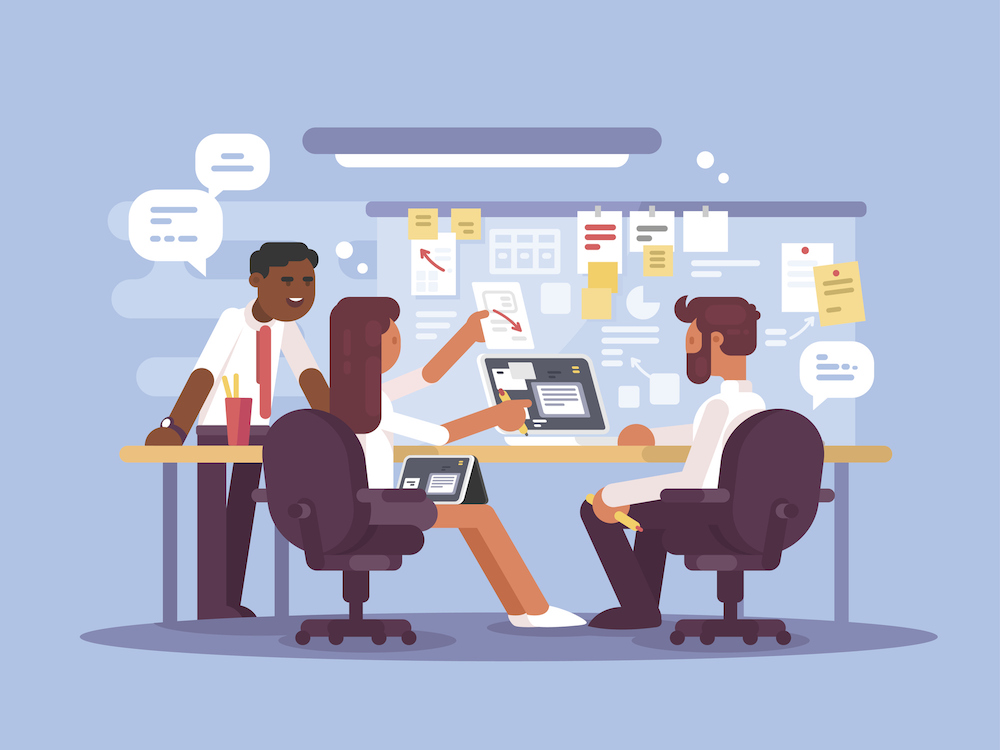The Best Way to Design an Office for Maximum Productivity and Morale

Congratulations!
You’ve graduated from fledgling entrepreneur to a growing startup with a small, but mighty staff.
Your next big acquisition: An office. While having your own space is clearly a step up the business ladder, you might not be thinking of it as an opportunity to craft company culture that serves your brand, vision, and process.
Think again. Many a study shows that the design of an office plays a big role in how companies perform.
So take advantage of the opportunity. To help you, we’ve put together this helpful checklist. Review these questions/criteria carefully; they will help you craft a holistically beneficial work environment that redounds to higher profits and team loyalty—instead of an uninviting cave that nobody wants to work in.
Open office or closed?
The open office—otherwise known as the “creative office”—gained major popularity in the 2000s. On some level, its appeal is clear:
- Easier communication and collaboration are possible, alongside the sense of a larger team working together toward higher ends
- Oversight is easier—no one can hide easily behind a door or divider
- Setup is less expensive than real estate with doored offices
- The flexibility afforded by movable desks and cubicles means you can switch a layout at will to serve company or staff changes
But there has been a surge of opinion lately that inveighs against the open office phenomenon. Here are some of the arguments against it:
- Noise from co-workers makes getting work done difficult
- Lack of physical boundaries means it’s easier to carry on idle conversation that takes employees off task
- The lack of hierarchy apparent in an open office can jeopardize the authority of the manager
- Damaging competition and idea-stealing between employees is easier
- Too many choices for employees to set up or find their own workspace may engender an undue sense of ownership
Before making a decision, also consider these factors:
- How often will you need to conduct private meetings—either internally or with clients? Will you have sound-proof spaces where you can hold these meetings?
- How frequently will your team need to engage with one another, and what will that engagement look like? If they consult with one another often, then consider cubicles with lower walls or desks that allow everyone to be seen easily. If not as often—and concentration is needed periodically throughout the day—consider higher cubicle walls for more sound protection and privacy.
- What would make your team feel comfortable? Ask them before you set up the workspace. Create workspaces that are easily customizable—with walls that can easily be used to hang photos or posters, and shelves where they can put knick-knacks.
- Human beings need social interaction, and you should encourage periodic casual engagement. Where will the team have the opportunity to take a break, chat, and unwind?
- Will you have access to a pleasant outdoor space? Enjoying a change of scenery is a great way to rejuvenate during a long day, or to reignite creativity in the middle of a trying project.
- Is organizational structure important? If so, be sure that your office will accommodate a manager or supervisor in a space that is set apart from the rest of the team—while still accessible. Otherwise, they may appear as more of a co-worker than a manager.
- Natural light encourages learning and improves overall mood. Will your entire team be regularly exposed to natural light?
Amenities—distractions or motivating perks?
Another corporate concoction from the 2000s was the in-office perk. Granted, these were around before then, but there was a massive inflation in office amenities around this time, largely in the tech industry.
As a way to set themselves apart, companies like Google and Apple started introducing lux coffee bars, pool tables, snack bars—heck, even cafeterias that offered high-quality food for free.
There’s no question that these bennies sound attractive. But not all companies can afford such indulgences, and many that can shouldn’t offer them anyway.
The pro argument is pretty clear. For a relatively small cost, an office can offer what seems to be a really cool perk. It’s amazing the value people put on free coffee, beer Fridays, and rotating snacks in the break room. Companies have taken advantage of that because they understand how important office culture is to employees—they’re spending at least 40 hours a week at work, after all. And if it seems like fun to be there, they’ll likely enjoy the work they’re doing and put more energy into it.
But the “free lunch” phenom can go too far. Tech companies—even those just off the ground—have been known to weave ridiculous treats and gimmicks into their workspaces. You know, like slides and swimming pools.
So before you line your walls with beer spouts and candy baskets, consider:
- What is your company’s vision? If you’re a health food or fitness company—or are generally focused on wellbeing—don’t offer a limitless supply of bad coffee and Oreos. This sends the message that those at the top are not really all that serious about your vision.
- What encourages better morale and higher productivity? Coffee is a given, but can also leave your team with an afternoon slump. Would it make more sense to offer free juice or tea? Ask your team what they would appreciate.
- Will games like ping-pong or fußball be a nice opportunity to unwind, or will they be a distraction? Not all spaces can handle this, so don’t force it just to be cool. If you still want games, consider simple board games instead that can be pulled out and played on occasion in common areas.
- What is the cost of adding the amenities you’d like, and do you think they will truly set you apart from competition while creating a fun, productive work environment?
Common areas—utilitarian hubs or fun spaces?
This isn’t an either/or situation; common spaces don’t have to be one or the other. In many cases, however, they are. I’ve worked in too many offices where the lunchroom was so drab—designed merely to be a space for a fridge and a microwave—that I preferred to eat at my desk.
As you can imagine, these spaces can improve or hurt morale, so consider them carefully:
- Will you have a kitchen space where employees can heat up lunches and store food in a refrigerator? How important is this to your team? And should you offer more (a full stove/oven, an adjoining dining room or eating space, etc.) to increase comfort and convenience?
- How much freedom will you have to design/decorate common areas? Encouraging the team to paint or decorate is a great way to get them working together in a fun way, while also really bringing out your team’s personality.
- With greater freedom comes greater responsibility—so if you give your team the freedom to build out your common spaces, will you be willing/able to task them with cleanup and maintenance?
- Where will you place your commonly used technology, such as printers, scanners, and phones? What about storage? If these are in one place, is it easily accessible while also being secure? What will be the need for privacy in this space?
- Will you have a common area that can be used for team fun—a place that people WANT to hang out in? (With comfortable seating, warm colors, plants, and natural light?)
- Will you have a space to post announcements and company-wide notices? Will the team be able to use this, too? (Many offices have now moved physical announcement boards to digital spaces, but a physical board can encourage more team interaction.)
- Will you have a place, visible to the entire office, where you can post your vision statement and core values?
General office layout questions
These thoughts come from several interior designers and gurus, and are worth an examination:
- How will you scale in this space when your company grows?
- Do you anticipate a change in process or product(s) that will alter how you do work? Can your office easily accommodate these changes?
- How frequently and in what capacity will clients or prospects be visiting your workspace? What experience do you want them to have? Walk through your office as though you were a client and make note of what you see/experience. This will help you figure out what to change.
Do’s and do-not’s of office organization
- Do not use mirrors. Yes, they make a space look bigger, but they also make people feel self-conscious. Avoid them.
- Do not set up your workspace so people’s back are to each other. It will make members of your team—and your clients—feel snubbed.
- Avoid positioning your chair against a window, especially if you regularly see clients. This makes you seem vulnerable.
- Do not use your office space like a bedroom; sports trophies and music posters don’t belong and can make others feel awkward or uncomfortable.
- Do face your personal/family photos toward yourself, not toward the door of your office or outward toward others. If you put them “on display,” it will seem like you trying to advertise a certain persona that comes across as artificial or pompous.
- If you plan on meeting with clients or having more formal meetings, do not use a standing desk. These are popular, but formal meetings should be held seated in comfortable chairs. (Standing while your client sits will make them feel vulnerable and inferior, while making him/her stand with you will put them on edge and make them uncomfortable.)
- Do keep cords hidden and supplies neatly stored; make sure common area tools are labeled; and provide receptacles for inner-office documents, trash, recycling. Office-wide cleanliness and organization will bleed over onto individual employees’ desks, which will encourage productivity.
- Do set guidelines that apply to all employees. If you have set boundaries around individual workspace design, make sure everyone adheres to it, including yourself.
#
Landing a new office is a big deal—and not just because it means you’re coming up in the world. It’s also a tremendous opportunity to encourage creativity, collaboration, and fun. Don’t miss that opportunity.
Speaking of organization and productivity, have you seen this incredible Morning Routine guide?
Sign up now to get our FREE Morning Routine guide—the #1 way to increase productivity, energy, and focus for profitable days. Used by thousands of fitness, business, and finance industry leaders to leapfrog the competition while making time for the people who really matter. Learn more here.
